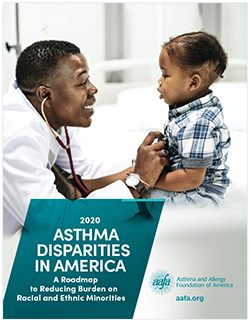The Asthma and Allergy Foundation of America (AAFA) released its Asthma Disparities in America report. This report looks at how asthma affects Black, Hispanic and American Indian/Alaska Native groups in the United States. These groups have the highest rates of asthma, hospital visits and asthma-related deaths.
People with asthma often have other allergic diseases, like food allergies. Disparities exist in food allergies too. Black children are 7% more likely to have food allergies than white children.1 Black and Hispanic children have higher rates of corn, shellfish and fish allergies. They also go to emergency room more and tend to have higher rates of anaphylaxis, a severe allergic reaction, than white children.2
Although health care quality has generally improved for many people in recent years, racial disparities in health are very concerning. This report is a call to fix the social inequalities caused by structural racism that affect at-risk people with asthma and allergies.
AAFA is calling for bold change to reduce the burden of asthma and allergy disparities on racial and ethnic minorities. The report outlines 69 strategies to improve health by supporting a "health in all policies" approach. Some of the strategies are specific to asthma, but many would improve health overall.
In health, if a condition – like food allergies or asthma – affects one group of people differently than another group, it is called a “health disparity.”
Next Steps
AAFA’s mission is to save lives and reduce the burden of disease for people with asthma and allergies through support, advocacy, education and research. This report is part of that mission. It outlines ways we can make to reduce asthma disparities and make lasting change. Improving asthma care for Black, Hispanic and Indigenous Americans improves asthma care for everyone. AAFA is working with many like-minded organizations and partners to effect change.
For more information, read the Asthma Disparities in America report or download it as a PDF. You can also share the report with your community leaders, health care providers and law makers.
This report is made possible by support from AstraZeneca, Genentech, Novartis, PhRMA and Sanofi Genzyme and Regeneron.
References
1. Bilaver, L. A., Kanaley, M. K., Fierstein, J. L., & Gupta, R. S. (2020). Prevalence and Correlates of Food Allergy Among Medicaid-Enrolled United States Children. Academic Pediatrics. doi:10.1016/j.acap.2020.03.005
2. Mahdavinia, M., Fox, S. R., Smith, B. M., James, C., Palmisano, E. L., Mohammed, A., . . . Gupta, R. S. (2017). Racial Differences in Food Allergy Phenotype and Health Care Utilization among US Children. The Journal of Allergy and Clinical Immunology: In Practice, 5(2). doi:10.1016/j.jaip.2016.10.006
How Can You Help Improve Health Disparities?
The only way we can tackle health disparities is if we all work together. Everyone – from people with food allergies and asthma to policy makers and the health care industry – can be a part of building programs that make a lasting difference for people, families and communities impacted by allergic diseases.
Sign up for KFA’s community to stay up to date about the following opportunities to get involved:
- Advocate for people affected by health disparities
- Participate in patient-centered research and clinical trials
- Join our Patient and Family Advisory Council
You can also donate to support KFA’s mission to create real and lasting change. KFA is a division of AAFA.

Comments (0)